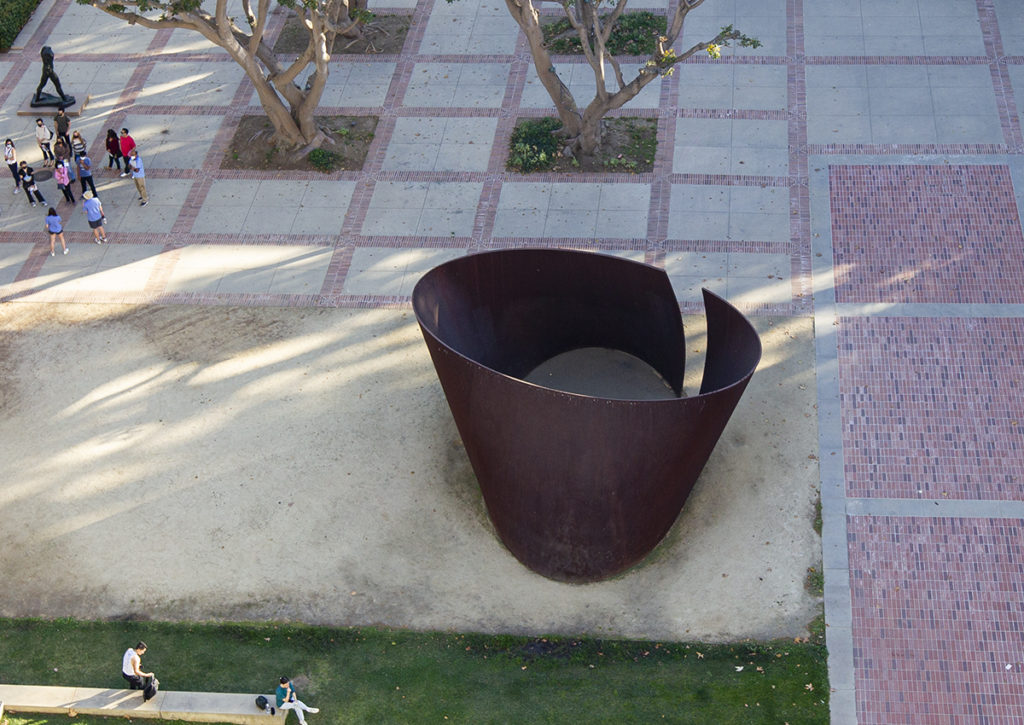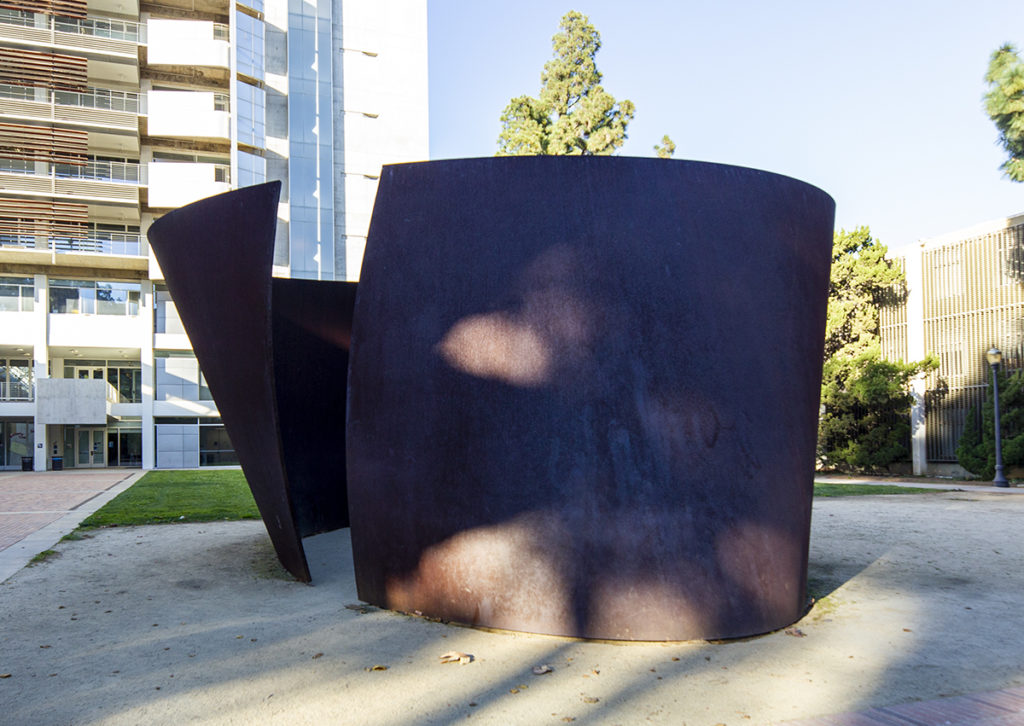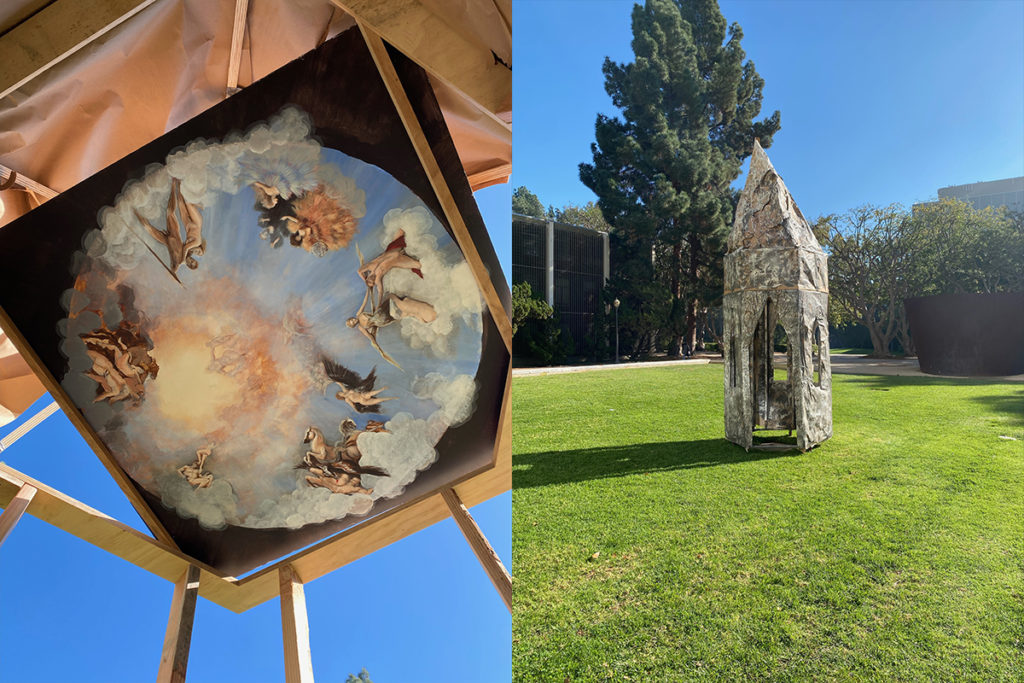Tour the garden: T.E.U.C.L.A. demonstrates importance of sculpture conservation

(Biona Hui/Daily Bruin)
By David Egan
Feb. 11, 2022 3:57 p.m.
As chancellor from 1960 to 1968, Franklin D. Murphy conceived of and curated UCLA’s Franklin D. Murphy Sculpture Garden. The bucolic hills and surrounding pathways, completed by architect Ralph Cornell in 1967, serve as a community hangout and the backdrop for some of the finest sculptures of the 20th century. Follow columnist David Egan as he explores the world of the sculpture garden and leads a tour of five artistic gems on North Campus.
Though the sculpture garden is far from South Campus, conserving its sculptures is as much a science as it is an art.
When a seam on William Turnbull’s stainless steel column mysteriously split, for example, sculpture conservator and alumnus Andrea Morse said her team employed an aerospace engineer to diagnose the problem. The sunlight in the garden caused two sides of the column to warm and expand, she said. Sculptures can be damaged by the elements and Morse’s business, Sculpture Conservation Studio, has maintained works in the garden for more than ten years, she said.
“(There is) acid rain, we have these downpours and then we have hot weather and weather is inconsistent,” Morse said. “The trees have a lot more pollen and sap and they get over the sculptures which cause problems.”
With these changing conditions as well as a gradual increase in visitors to the garden, Morse said her conservation team works more regularly than they did in prior years. For a standard bronze sculpture, she said they dust the work, rinse it with distilled water and wash it with biodegradable, pH-balanced soap. The conservators also wax sculptures to give them protective coatings, or occasionally hot wax sculptures, using a propane torch to remove moisture from the metal to thoroughly dry the work, Morse said.
[Related: Tour the Garden: The Walking Man embodies the sculpture garden’s historical, artistic context]
Beyond the standard sculptures in the garden, Morse said one work poses particular conservation challenges: Richard Serra’s 2006 T.E.U.C.L.A. As part of a series of Torqued Ellipses, Serra made this large sculpture with COR-TEN steel, which should develop a patina, a green or brown film produced by exposure to oxygen over time. But vandalism with pen and paint – as well as the occasional super-frisbee game played inside the work – has interfered with the process, Morse said.
“(‘T.E.U.C.L.A.’) wasn’t exactly designed to be on a public property because the shape of it, the teepee shape that people could go in,” Morse said. “You cannot see what’s going on inside it. That has hurt the COR-TEN forming its own special color patina.”

Besides graffiti, Morse said the different patina on the inner and outer walls is a result of Serra’s request for the ground inside the sculpture to be decomposed granite compound, a form of chalk. She said visitors use the substance to add footprints and handprints on the walls, which themselves need to be washed off. When Sculpture Conservation Studio cleans the walls of T.E.U.C.L.A., it also washes off the patina, which has to begin to grow all over again, Morse said.
Regarding Serra’s artistic form, alumnus Moses Mascuch, who formerly led tours of the sculpture garden and is a current assistant for the academic programs department at the Hammer Museum, said he appreciates how viewers can move in and around T.E.U.C.L.A., an imposing work. His first assignment for the art history course “Modern Art” was to compare the sculpture to Auguste Rodin’s The Walking Man, he said.
“(T.E.U.C.L.A. is) a sculpture that you can both be on the inside of and on the outside of,” Mascuch said. “That’s interesting compared to the openness of the garden – that you have, if you so choose, a more enclosed private space where those walls are towering above you.”

[Related: Tour the Garden: Alexander Calder’s Button Flower epitomizes community focus of outdoor sculpture]
This cumbersome bulkiness is a defining feature of the sculpture to fourth-year art student Gwyneth Bulawsky, she said. Bulawsky wanted to divert attention from the looming work with her sculpture Ascension, the final project for a sculpture class that she temporarily displayed in front of the Broad Art Center in the fall. Bulawsky said she intentionally positioned Ascension, a 16-foot tall hexagonal, Catholic-style cathedral, right beside T.E.U.C.L.A. to highlight the visual contrast between the works.
With Ascension, Bulawsky wanted to create an inclusionary place of worship with ceiling frescoes that dealt with transgender themes, she said. She played club music in the cathedral – an homage to nightlife as a queer safe space – and referenced Greek mythological figures Prometheus, Athena and Zeus on the fresco. Mythology is relevant to queer culture, Bulawsky said, as ideas of transformation and rebirth reflect the process of being born into a physical body or circumstances one did not ask for and emerging to assert one’s identity regardless.
“I liked the idea that the sculpture was not permanent, that it would just exist for a brief moment in time, that the materials used were wood and were paper – and the fragility of it, to exist next to something like the Serra, which is like a 42-ton metal sculpture,” Bulawsky said.

Conserving contemporary art – such as a sculpture like Ascension – may require asking artists about the particularities of how they want works maintained or if they want them touched up at all, Morse said. Other museums and outdoor art collections have coated their Serra sculptures with an anti-graffiti coating, but she said that itself would ruin the patina. For UCLA’s sculpture garden, which has no stated rules against interacting with works, Morse said it would be best to teach the public not to damage the art.
“We love the garden,” Morse said. “I used to walk through the garden as a student and I never had any idea that I would be grown up and be maintaining it, so it’s real special to me.”


